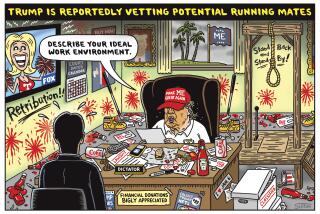OLIPHANT’S PRESIDENTS Twenty-Five Years of Caricature <i> text by Wendy Wick Reaves (Andrews & McMeel: $12.95) </i>
- Share via
Australian-born Pat Oliphant ranks as the wittiest political cartoonist working in the United States today. Paul Conrad is more dramatic; Herb Block (“Herblock”) more humane; Mike Peters more broadly comic. Oliphant’s caricatures sting with the excruciating delicacy of a needle hidden in chinchilla fur.
The recipient of numerous awards, including the Pulitzer Prize, the Sigma Delta Chi Award, the National Cartoonists Society’s Reuben Award and an honorary degree from Dartmouth, Oliphant is also the most influential political cartoonist to emerge in the last 25 years. His clean, simplified drawing style, which can be read at a glance (even when greatly reduced and smudgily printed), has profoundly affected the work of the best cartoonists of the BabyBoom generation: Jeff MacNelly, Tony Auth, Doug Marlette, Mike Peters, Tom Toles. His device of having a recurring character (Punk the penguin) comment on his cartoons has been copied widely--sometimes well, often badly.
The significance of his work is attested to by an unprecedented exhibit at the Smithsonian Institution’s National Portrait Gallery, which remains on display through November 25. “Oliphant’s Presidents,” which serves as a catalogue for the exhibition, provides a neat overview of his work.
Oliphant came to the United States to replace Conrad as editorial cartoonist for the Denver Post in 1964, during the Johnson administration. His early work combined fully rendered caricatures with simply drawn secondary figures. An early cartoon of LBJ crooning “Do not forsake me, oh, mah darlin’ ” to a woman labeled Public Support illustrates the dichotomy: Johnson is drawn accurately but stiffly; Public Support is a cartoonish cipher with dots for eyes.
It was during Richard Nixon’s presidency that Oliphant matured as a cartoonist. He learned to make his caricatures simpler and freer, and the symbolic figures more complex, producing a witty, unified style that packed a visual wallop. The last vestiges of his early style can be seen in a drawing of the newly elected Nixon literally trying to ram the ABM down a taxpayer’s throat.
This fussy version of Nixon as a shifty-eyed used-car salesman gradually deconstructed into a bloated portrait of malevolence with sagging jowls and glaring eyes. A late sketch of Nixon as a buzzard on Ronald Reagan’s shoulder recalls Thomas Nast’s famous cartoon of the members of the Tweed Ring as a pack of vultures threatened by the storm of public wrath (“Let us prey”).
Gerald Ford’s bland countenance lacked the prominent features that can be caricatured effectively. Oliphant never seems to have taken Jimmy Carter very seriously: His drawings of Carter amount to little more than clumps of hair, eyes and teeth. Significantly, the images of both men shrank in his cartoons as they shrank in stature during their terms of office.
Ronald Reagan provided better material: Oliphant drew him with an elongated upper lip, a slick pompadour and a vacant stare. He initially attacked the falseness of Reagan’s image, labeling him “The Cardboard Messiah,” but soon switched to satirizing the President’s detachment and tenuous grasp of reality. One of his funniest cartoons turns the administration into the Mad Tea Party, with Reagan as a perplexed Mad Hatter, Nancy as a glowering Queen of Hearts and George Bush as a vapid March Hare. Since the ’88 election, Oliphant has continued to draw Bush as an effete wimp with a vacuous, upbeat grin.
Most of the color plates in the book are devoted to Oliphant’s bronze sculptures, which are essentially three-dimensional cartoons: Carter becomes a diminutive, gloomy fence-sitter; Nixon a baleful Napoleon fleeing Moscow; Reagan a cowboy whose horse collapses under him.
In her brief but ponderous text, Wendy Wick Reaves sometimes seems to miss the point of the cartoons. When Oliphant depicts Reagan as an aging gunslinger preparing to shoot a bee (Fidel Castro) off Uncle Sam’s nose, Reaves describes the President as having “a steady hand and complete confidence in hitting the target.” But Oliphant has drawn Reagan using both hands to steady the heavy pistol.
But any notes probably would seem superfluous with these cartoons. Pat Oliphant is a devastatingly astute observer of the American political scene: His drawings speak for themselves.
More to Read
The biggest entertainment stories
Get our big stories about Hollywood, film, television, music, arts, culture and more right in your inbox as soon as they publish.
You may occasionally receive promotional content from the Los Angeles Times.










